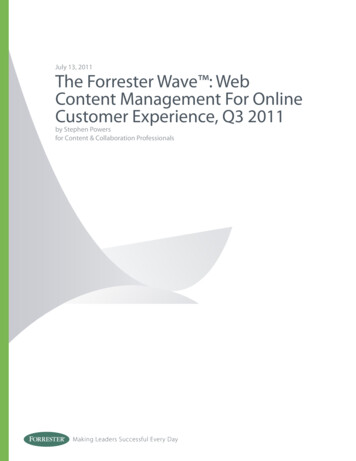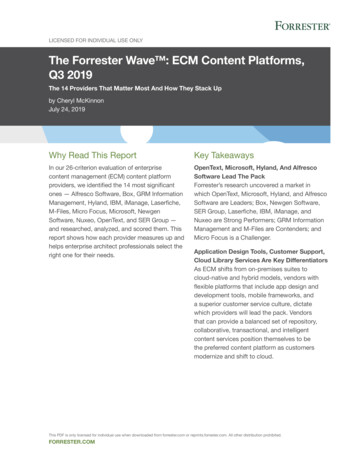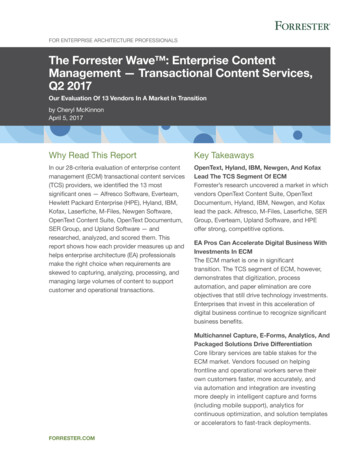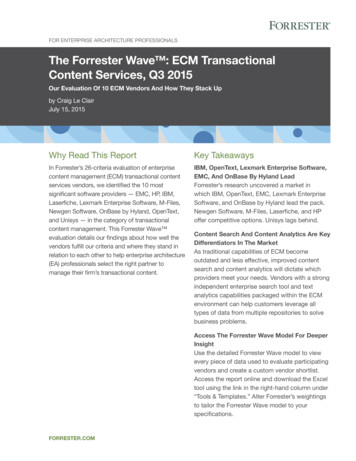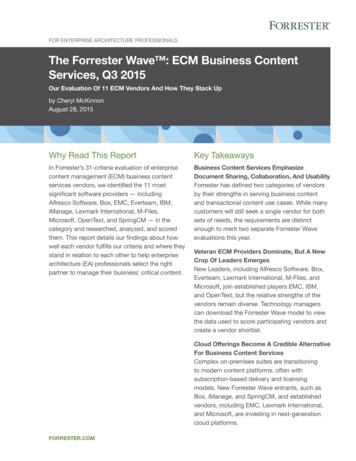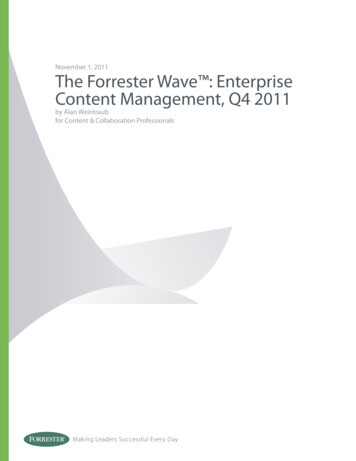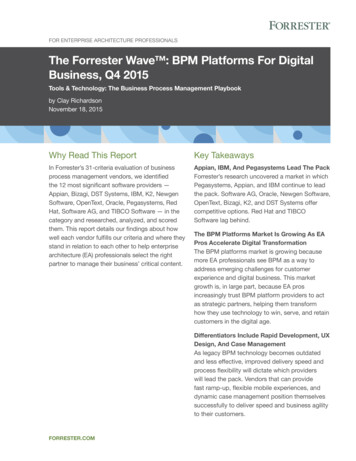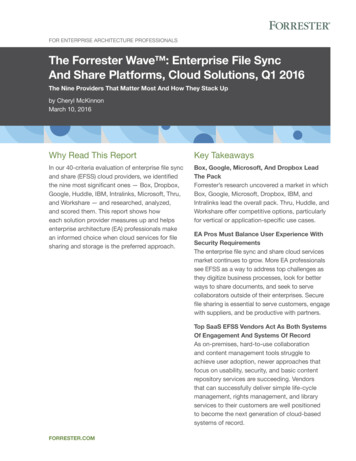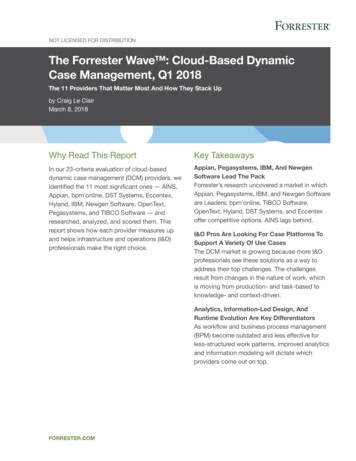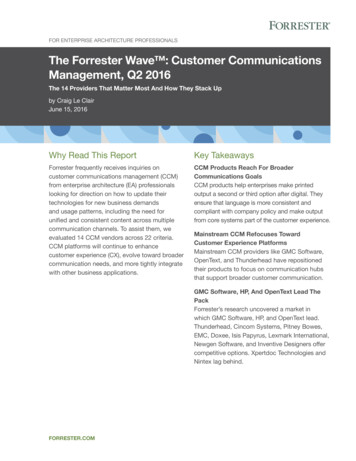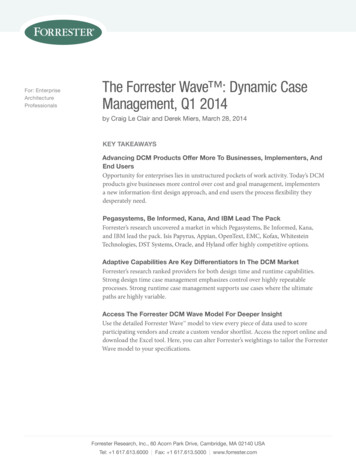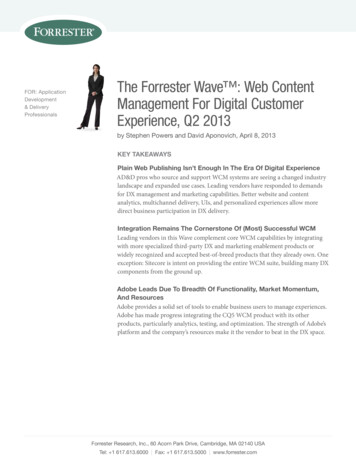
Transcription
For: ApplicationDevelopment& DeliveryprofessionalsThe Forrester Wave : Web ContentManagement For Digital CustomerExperience, Q2 2013by stephen powers and David Aponovich, April 8, 2013Key TaKeaWaysplain Web publishing isn’t enough in The era of digital experienceAD&D pros who source and support WCM systems are seeing a changed industrylandscape and expanded use cases. Leading vendors have responded to demandsfor DX management and marketing capabilities. Better website and contentanalytics, multichannel delivery, UIs, and personalized experiences allow moredirect business participation in DX delivery.integration Remains The Cornerstone of (Most) successful WCMLeading vendors in this Wave complement core WCM capabilities by integratingwith more specialized third-party DX and marketing enablement products orwidely recognized and accepted best-of-breed products that they already own. Oneexception: Sitecore is intent on providing the entire WCM suite, building many DXcomponents from the ground up.adobe Leads due To Breadth of Functionality, Market Momentum,and ResourcesAdobe provides a solid set of tools to enable business users to manage experiences.Adobe has made progress integrating the CQ5 WCM product with its otherproducts, particularly analytics, testing, and optimization. The strength of Adobe’splatform and the company’s resources make it the vendor to beat in the DX space.Forrester research, inc., 60 Acorn park Drive, cambridge, mA 02140 UsAtel: 1 617.613.6000 Fax: 1 617.613.5000 www.forrester.com
For Application Development & Delivery ProfessionalsApril 8, 2013The Forrester Wave : Web Content Management For DigitalCustomer Experience, Q2 2013Adobe Offers A Leading Combination Of Strategy And Resourcesby Stephen Powers and David Aponovichwith John R. Rymer and Rowan CurranWhy Read This ReportWeb content management (WCM) software has evolved from a set of primarily technical tools for websitemanagement into broad products and suites that support the imaginations (and needs) of digital marketerscreating multichannel digital experiences. In Forrester’s 100-criteria evaluation of WCM vendors, weidentified the 10 most significant providers in the category — Adobe, Acquia, Ektron, HP Autonomy, IBM,Microsoft, OpenText, Oracle, SDL, and Sitecore — and evaluated them in three areas: current offering,strategy, and market presence. Application development and delivery (AD&D) professionals and theirmarketing and business peers can use these findings to understand the new generation of WCM solutionsand select the right one to support their digital customer experience requirements.Table Of ContentsNotes & Resources2 WCM Is Evolving From Website Publishing ToDigital Experience SupportForrester conducted product demonstrationsin December 2012 and January 2013and examined 10 vendor companies. Weinterviewed nine of them: Adobe, Acquia,Ektron, HP Autonomy, IBM, Microsoft,OpenText, SDL, and Sitecore. Oracledeclined to participate. We also interviewedup to three customers of each vendor.WCM Isn’t A Suite Story, It’s An IntegrationStory4 Many Vendors Are Jumping On TheCustomer Experience Bandwagon5 WCM For Digital Customer ExperienceEvaluation OverviewVendor Selection Criteria7 The Results: Adobe Leads, But Other SolidOptions Are Available9 Vendor ProfilesLeadersStrong PerformersContenders13 Supplemental MaterialRelated Research DocumentsChoose Digital Experience Tools To EngageWith Customers In A Cross-Channel WorldFebruary 12, 2013Digital Customer Experience Trends ToWatch, 2013January 30, 2013Unify The Digital Experience AcrossTouchpointsAugust 22, 2012 2013, Forrester Research, Inc. All rights reserved. Unauthorized reproduction is strictly prohibited. Information is based on best availableresources. Opinions reflect judgment at the time and are subject to change. Forrester , Technographics , Forrester Wave, RoleView, TechRadar,and Total Economic Impact are trademarks of Forrester Research, Inc. All other trademarks are the property of their respective companies. Topurchase reprints of this document, please email clientsupport@forrester.com. For additional information, go to www.forrester.com.
For Application Development & Delivery Professionals2The Forrester Wave : Web Content Management For Digital Customer Experience, Q2 2013WCM Is evolving from website publishing to digital experiencE SupportWeb content management (WCM) vendors continue to add capabilities to assist marketers withtheir need to support an expanding, multichannel digital world. The goal? To support the abilityto create and manage engaging multichannel experiences for customers, partners, and prospects.1Ultimately, WCM tools are no longer just about managing web content. Instead, they have evolvedto become the cornerstone of an ecosystem of tools that support digital experiences for customers.2These digital experience (DX) solutions generally fall into one of three categories that Forresterrefers to as “manage, engage, and measure:” Solutions that enable nontechnical personnel to manage experiences. These solutions consistof tools and repositories that marketers and other nontechnical personnel use to create andmanage structured and unstructured content for customer experiences. This category includesWCM, digital asset management (DAM), product catalog management, workflow, campaignmanagement, marketing resource management, and desktop authoring tools. Engagement solutions that enable the delivery of interactive multichannel experiences.Vendors often tightly couple WCM and eCommerce solutions with management and deliverycapabilities, enabling businesses to create content and deliver experiences in a single package.But other technologies enable experience delivery, including discrete content targetingsolutions such as search, personalization, and recommendations engines, tools to enable thedevelopment of presentations like integrated development environments, ad-serving systems,and identification and authorization management tools. Measurement solutions that allow businesses to gauge the success of experiences. A/B andmultivariate testing enable marketers and business users to test out variations of experiences oncertain demographics before rolling them out to a broader audience. Web analytics tools trackwebsite visitor behavior. Social analytics tools track how consumers engage with companies bymonitoring social interactions. And dashboards present analytical data from which marketerscan draw actionable insights.WCM Isn’t A Suite Story, It’s An Integration StoryWCM does not, and should not, provide all the tools needed to support a “manage, engage, measure”paradigm. While some capabilities, such as versioning, check-in/check-out, and workflow, arenative to WCM — and are generally commoditized across the vendor landscape — complementarycapabilities already exist in other products that organizations have already invested in. Buyersshould be clear on what they’re looking for in a WCM, what they will get from adjacent products,and whether these capabilities may overlap (see Figure 1). 2013, Forrester Research, Inc. Reproduction ProhibitedApril 8, 2013
For Application Development & Delivery ProfessionalsThe Forrester Wave : Web Content Management For Digital Customer Experience, Q2 20133The strategies and tactics that WCM vendors have employed as they’ve entered the DX businessrun the gamut: designing fresh user interfaces (UIs); creating easier editing tools; focusing onpersonalization and targeting tools; adding marketing automation capabilities, embedded analytics,and intelligence; and more.3 But no single vendor’s current portfolio has all of the tools necessary tosupport DX. Even if the ideal single-vendor platform existed, our clients tell us that they’ve alreadymade too many investments to be able to rip and replace all of their existing tools in favor of a singlesuite or vendor platform.Dealing with fewer vendors and fewer products should remain a goal. But WCM buyers shouldseek solutions that are built on open standards and have prebuilt integrations and partnerships withproven, mature best-of-breed applications for DX and online engagement efforts rather than all-inone suites. Enterprises typically own many of these systems already, so integration should be theideal; in fact, it’s a crucial differentiator for WCM.4 Forrester’s research finds that integrating WCMwith other best-of-breed systems like eCommerce, analytics, marketing automation, and emailmarketing is a high priority as firms source and build next-gen cross-channel marketing platforms.Companies frequently tell us that they are committed to their previous investments in areas suchas analytics, optimization, email campaigns, and eCommerce and want their WCM systems tointegrate with, not replace, their existing solutions.Figure 1 Core And Adjacent WCM CompetenciesCore to WCMAdjacent technologyManage Content repository Content authoring Classification Taxonomy management Permissions Workflow Layout management Rich media management eForms Segmentation management Content authoring Translation Customer relationship management Product catalog management Digital asset management eForms Segmentation management Campaign management Business process management Desktop authoringEngage Presentation authoring Content targeting Email campaign delivery Polling and feedback Presentation authoring Content targeting Commerce transactions Social networks Mobile application development Ad servingMeasure A/B testing Reporting Search engine optimization82462 2013, Forrester Research, Inc. Reproduction Prohibited Multivariate testing Web analytics Social analytics Search engine optimizationSource: Forrester Research, Inc.April 8, 2013
For Application Development & Delivery Professionals4The Forrester Wave : Web Content Management For Digital Customer Experience, Q2 2013Many vendors Are jumping on the customer experience bandwagonA significant number of vendors, both large and small, offer a set of tools that enable organizationsto manage, engage, and measure multichannel digital experiences: DX platform players support companies requiring breadth and depth. Large vendors likeAdobe, IBM, and Oracle can appeal to enterprise buyers seeking a deep stack of infrastructureor complementary tool sets from a single vendor. Each has broad offerings that include coreWCM plus related infrastructure for building and supporting the marketer’s challenge to manage,engage, and measure DX. Adobe has aggregated several technologies under Adobe MarketingCloud: Adobe Experience Manager (CQ5 WCM, with dynamic media and delivery via Scene7 integration), plus Adobe Analytics, Target, Social, and Media Optimizer. IBM offers WCM,portal, eCommerce, and marketing tools and more under its IBM Customer Experience Suite.Oracle WebCenter includes WCM (the former FatWire Software product that it acquired), Portal,and other tools. SDL also aims to play in the DX space, complementing WCM and best-of-breedglobalization/localization capabilities with tools for multichannel delivery (it recently boughtmobile solutions provider Bemoko), recommendations, and marketing automation. However,SDL’s DX technology portfolio isn’t nearly as extensive as the others mentioned in this category. Legacy WCM vendors look to nurture existing customers and expand their purview. Youcould call the companies in this category the stalwarts of the WCM world — they’ve been on thescene for years, providing solid WCM capabilities and serving diverse customers. They’re alsoexpanding their capabilities to answer the broader needs of DX management. HP Autonomy(which owns the former Interwoven products) and OpenText (which owns the former Vignetteand RedDot systems) each nurtures a large installed base and has a proven track record withinlarge enterprises. Dedicated WCM specialists leverage their product focus and rapid innovation. Thesecompanies focus on core WCM plus (in most cases) DX innovation. Ektron and Sitecore, whichwe evaluated for this report, both fall into this category but have distinct market positions, targetcustomers, and road maps. Other specialist vendors include Bridgeline Digital and PercussionSoftware, SaaS players CrownPeak and Limelight Networks, and Europe-based vendors such asCoreMedia, EPiServer, e-Spirit, eZ Systems, GX Software, Hippo, Kentico Software, and Telerik(which makes the Sitefinity product). Open source is appealing more to enterprises. Open source solutions abound in the WCMworld. Forrester clients will find the base level of functionality of these solutions lower thanthose of many of the commercial vendors in terms of DX capabilities, but those that are lookingfor a lower initial investment or need to extensively customize will want to consider it. Thisreport evaluates Acquia, a commercial company delivering support, hosting, and other servicesfor the open source product Drupal. The open source world includes other solutions withcommercial backing — such as those from DotNetNuke, eZ Systems, Jahia Solutions, MagnoliaInternational, and OpenCms — and those that are community-based, such as Joomla and Plone. 2013, Forrester Research, Inc. Reproduction ProhibitedApril 8, 2013
For Application Development & Delivery Professionals5The Forrester Wave : Web Content Management For Digital Customer Experience, Q2 2013WCM FOR Digital CUSTOMER EXPERIENCE EVALUATION OVERVIEWAfter examining past research, user needs assessments, and vendor and expert interviews, wedeveloped a comprehensive set of evaluation criteria. We evaluated vendors against 100 criteria,which we grouped into three high-level buckets: Current offering. To assess product strength, we evaluated each offering against seven groupsof criteria: 1) content management; 2) websites and layout; 3) globalization and localization;4) content targeting; 5) multichannel; 6) social and community controls; 7) publishing anddeployment; and 8) measurement. Strategy. We reviewed each vendor’s strategy, evaluating how well each vendor’s plannedenhancements will position it to support current and evolving multichannel WCMrequirements, and whether or not the vendor has a path to deliver those enhancements given itscurrent technology, internal resources, and partnerships. Market presence. To determine a vendor’s market presence, we evaluated each vendor’sinstalled base, company financials, professional services, and global presence.Vendor Selection CriteriaIn this Wave , Forrester evaluated vendors that enable marketing and business teams to useWCM in conjunction with other components of the DX ecosystem to support rich, interactive,multichannel customer experiences. Forrester included 10 vendors in the assessment: Acquia,Adobe, Ektron, HP Autonomy, IBM, Microsoft, Oracle, OpenText, SDL, and Sitecore.5 The WCMmarket remains somewhat fragmented, but these 10 vendors represent the strongest that the markethas to offer firms within Forrester’s client base in terms of stability, functionality, and experienceproviding a primary enterprise WCM product. Specifically, each of these vendors has (see Figure 2): A product that supports an interactive multichannel experience, not just web publishing.Products in this category not only have content management and web publishing capabilities,but also have capabilities — such as content targeting, social tools, and enterprise applicationintegration — that support interactive multichannel experiences. A significant track record as the primary WCM for customer experience in large companies.This category comprises vendor solutions that primarily target organizations with revenuesof more than 1 billion per year. WCM vendors in this category focus on enterprise-classorganizations, scale to serve large user populations, support highly trafficked websites, and offermultisite and multilingual support. Interest from Forrester clients. Forrester clients repeatedly ask about the evaluated productswithin the context of inquiry, advisory, and consulting, and/or have them installed as theprimary WCM for supporting DX-based websites. 2013, Forrester Research, Inc. Reproduction ProhibitedApril 8, 2013
For Application Development & Delivery Professionals6The Forrester Wave : Web Content Management For Digital Customer Experience, Q2 2013 A minimum of 35 million in annual revenue. Vendors included in this evaluation have aproven product and generate approximately 35 million or more in annual revenue.For purposes of this Forrester Wave, the products and solutions that we reviewed were those thatwere generally available on or before October 10, 2012.Figure 2 Evaluated Vendors: Product And Vendor Information And Selection CriteriaVendor nameProduct name and versionAdobeCQ 5.5AcquiaDrupal 7EktronEktron 8.6HP AutonomyTeamSite/LiveSite 7.3.2IBMIBM Customer Experience Suite 8.0MicrosoftSharePoint 2013OracleWebCenter Sites 11gR1OpenTextOpenText Web Experience Management 8.1SDLSDL Tridion 2011 SP1SitecoreSitecore CEP 6.5Inclusion criteriaA product that supports interactive multichannel experiences, not just web publishing.A significant track record as the primary WCM for customer experience in large organizations.Interest from Forrester clients.A minimum of 35 million in annual revenue.Source: Forrester Research, Inc. 2013, Forrester Research, Inc. Reproduction ProhibitedApril 8, 2013
For Application Development & Delivery Professionals7The Forrester Wave : Web Content Management For Digital Customer Experience, Q2 2013the results: adobe leads, but other solid options are availableThe evaluation uncovered a market in which (see Figure 3): Adobe leads with breadth and momentum, while Sitecore and SDL pursue DX strategies.All three vendors provide a solid set of tools enabling marketing and eBusiness professionalsto manage content, deliver engaging experiences, and measure results. Adobe has the richest,most intuitive UI of the three, as well as the best complementary DX products and thedeepest pockets, while SDL continues to excel in the areas of globalization and localization.Sitecore takes more of a suite approach, offering more native components and fewer packagedintegrations with best-of-breed products than the others. OpenText, Oracle, and HP Autonomy offer competitive options for their installed bases.OpenText continues to offer a solid WCM product, although it’s most compelling for companiesthat already own other OpenText products and are looking for a single throat to choke.Longtime WCM player Autonomy, now part of HP, still has a solid feature set, but the numberof Forrester clients asking about it has declined over the past several years; two changes ofownership surely haven’t helped. Oracle has a broad set of DX capabilities in its portfolio, butuntil it achieves significant integration between the components of that portfolio, its WCMproduct (acquired from FatWire) isn’t compelling beyond Oracle shops, particularly whencompared with the work that Adobe and IBM have done on their DX offerings. IBM offers improved WCM and integrates with a broad portfolio of DX products. IBM’sproduct has significantly improved since our last evaluation 18 months ago. But its real valuelies in the current and potential future integrations with best-of-breed IBM products in theareas of eCommerce, analytics, and other marketing enablement tools.6 Ektron, Microsoft, and Acquia offer solid WCM, but DX questions remain. Ektron has themost functionality of the Contenders in this report, and an ambitious strategy to integrate withthird-party DX components, but we question whether it has the market presence and resourcesto execute. SharePoint has supported informational websites in the past, but Microsoft has onlystarted to talk about interactive multichannel experiences with SharePoint 2013; the vendorhas a lot of ground to make up if it wants to seriously compete in this space. Acquia, whichleverages the open sou
the Forrester Wave: Web content management For Digital customer experience, 2 2013 4 2013, Forrester research, inc. reproduction prohibited April 8, 2013 Many VendoRs aRe JuMping on The CusToMeR expeRienCe BandWagon A significant number of vendors, both large
